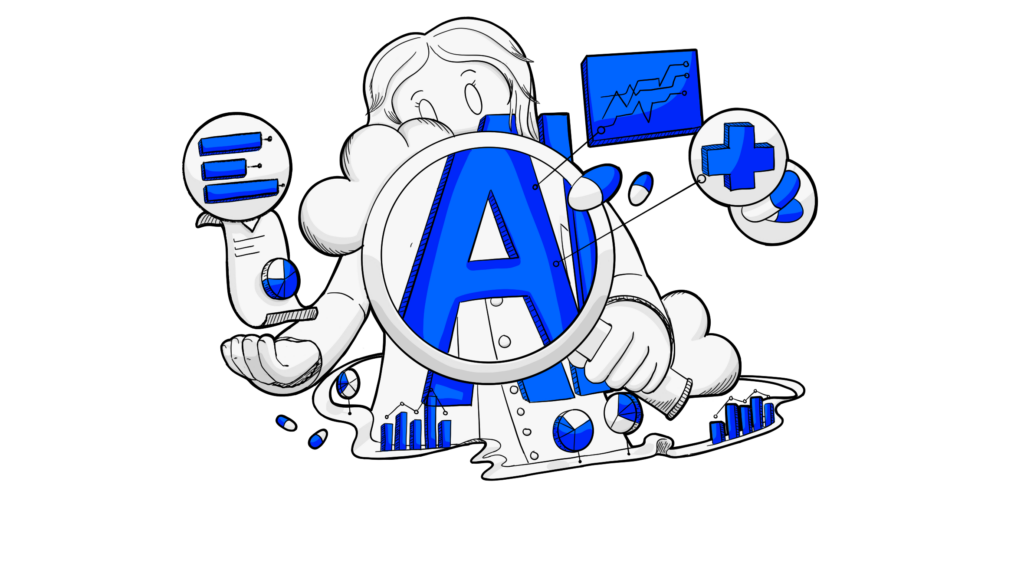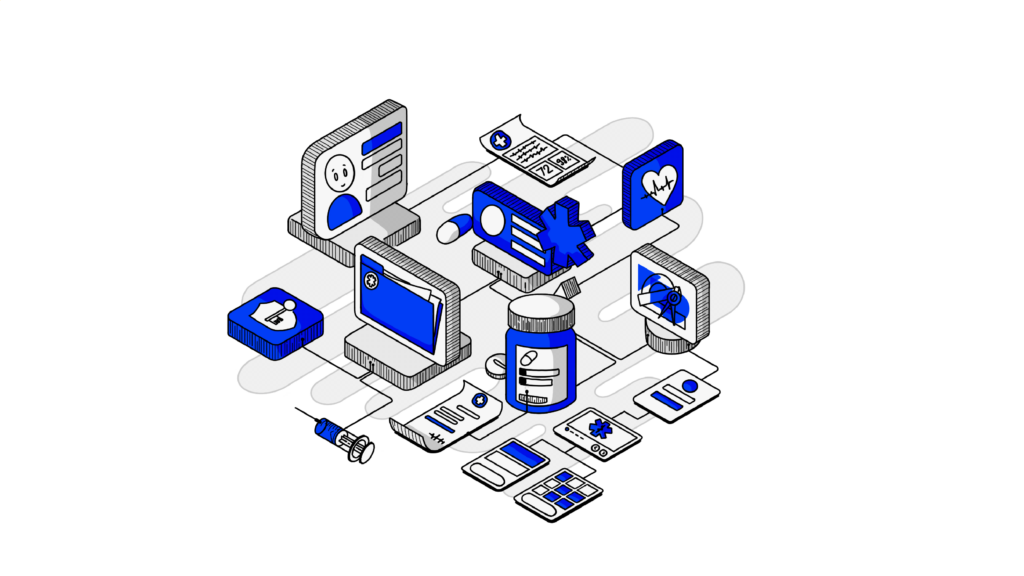1. The need for interactive content
1.1 Changing learning preferences
Education in the healthcare industry traditionally took the form of virtual conferences, didactic lectures, and scientific journals. In 2024, according to an EPG Health report about HCPs’ information needs and preferences, 74% of the respondents considered consuming medical information from independent medical websites critical.
At the same time, the report also shows that 41% of HCPs consume social media content, especially those under 34. As the younger, digital generations occupy more roles in the healthcare systems, there is a clear shift towards more interactive and engaging learning formats. Modern HCPs seek more dynamic and practical education approaches beyond passive listening.
Interactive content that can provide engaging experiences seems the obvious solution to these changing preferences. This shift is not just about keeping up with trends but addressing the fundamental need for more effective learning methods. Providing personalized content and immersive learning allows HCPs to participate actively in their education. This, in return, increases accountability and information retention, leading to more robust digital HCP engagement, which benefits all parties in the healthcare ecosystem.
1.2 Benefits of interactive learning
Speaking of benefits, let’s see some concrete advantages that interactive content for HCPs offers over traditional methods:
- HCP engagement: The more interactive the content, the more attention it captures and maintains. Millions of apps that use interaction mechanisms to keep the target audiences engaged have already tested and proven this. Engagement metrics are easy to measure. As a bonus, an interactive experience can also provide enjoyment, boosting HCPs’ attachment to your brand.
- Improved knowledge retention: We see it in schools, adult training programs, and learning apps, and for good reason. Active participation and hands-on experiences are proven methods of reinforcing learning, leading to better information retention.
- Practical application: Nothing attracts more than content that resonates with one’s interests. Interactive methods like virtual simulations and case studies allow HCPs to apply knowledge in real-world scenarios, enhancing their practical skills.
- Immediate feedback: Knowing how you performed in a quiz or getting immediate answers to a question in a live chat are excellent ways to maintain interest, correct mistakes, and understand concepts more deeply. Interactive modular content that offers real-time feedback can increase interest in an HCP engagement platform.
- Flexibility and accessibility: One great advantage of digital learning channels is that they can be accessed anytime and anywhere. This offers flexibility for busy professionals to learn at their own pace. Also, considering that HCPs have different degrees of digital savviness, they need to be able to access learning content that suits their digital preferences and affinity.
1.3 Limitations of traditional webinar-based continuing medical education (CME)
Webinars have been a staple in CME. They are still a preferred means to deliver products or medical information by pharmaceutical companies. While they can still prove effective in pharma product launches, when it comes to the learning process, they bear several limitations:
- Passive learning: As we’ve discussed before, effective customer engagement happens through interaction. Webinars typically involve one-way communication, where learners passively receive information without active engagement.
- One-size-fits-all content: traditional webinars don’t deliver personalized content. They cannot address the specific needs and learning styles of individual HCPs, which represents a strategic approach for any pharma company that wants to make omnichannel engagement part of the pharma marketing efforts (and you want to do that).
- Limited interaction: Opportunities for interaction are minimal, often restricted to Q&A sessions at the end of the presentation. One would think that HCPs are not interested in interacting, but driving conversations in a smooth, easy-to-access manner can very well add value to the customer experience.
- Retention issues: An unengaged audience translates into less time spent on your virtual events. Passive listening may lead to lower retention rates compared to interactive and hands-on learning methods. And you want HCPs to be more present on your HCP portals, don’t you?

2. Types of interactive content
Before going through some examples of interactive content for HCPs, it is necessary to note the prevalence of relevant content over technological performance. In other words, for HCPs the “what” weighs more than the “how”.
No matter how dazzling the tech medium is, if the delivered learning content is too general or does not cover the HCPs’ particular medical interest, it will turn into a wasted effort. When your pharma company commits to relevance no matter the content formats, it will positively impact HCP engagement, which leads to building trust in your brand.
Now, let’s take a look at some possible implementations:
2.1 Virtual simulations
It is well-known that practical learning is one of the most efficient methods to absorb and fixate new information. Virtual simulations are immersive educational tools that replicate real-world scenarios are key trends in learning and digital engagements.
They can be obtained by using augmented reality (AR) and virtual reality (VR) applications. By providing this hands-on learning approach, you allow HCPs to practice clinical skills, make decisions, and see the outcomes in a risk-free environment. This, in turn, enhances practical knowledge and confidence.
2.2 Interactive modules and e-learning courses
E-learning courses are no news. Still, when designed as interactive modular content, they can deliver personalized learning experiences, adapted to particular HCP interactions, interests, preferences, and digital savviness.
These modules can incorporate interactive multimedia elements such as videos, quizzes, and interactive exercises, which can be tailored to specific learning objectives and offer a self-paced learning environment.
2.3 Gamification
Gamification is an engagement method already in use in a wide range of applications. Though associated with entertainment purposes (where it originated), it proved its effectiveness in all areas, because it addresses basic psychological human needs.
Why not harness the power of gamification in interactive content for HCPs, as well? Basically, it involves incorporating game elements into educational content to make learning more engaging.
When you design dynamic content for HCP portals, include points, badges, leaderboards, and challenges to motivate HCPs to engage with the material actively and compete with peers. It will enhance both learning and enjoyment.
2.4 Education materials for patients
In a study by EPG Health, it was revealed that 68% of HCPs look for patient-friendly tools and materials to explain medication schemes, in order to increase medication adherence. A digital comprehensive guide, videos, or interactive schemes that offer easy-to-understand explanations can provide valuable support to HCPs in their relationship with patients.
2.5 Case studies
Medical content presented as interactive case studies provide real-life scenarios that HCPs must analyze and solve, requiring learners to apply their knowledge to practical situations. With the help of these studies, HCPs can strengthen their critical thinking and decision-making skills.
3. Designing effective interactive CME programs
Interactive CME programs are an important part of your HCP engagement strategy. Just as you do in your marketing strategy, before thinking about what technology to choose, the learning content strategy needs to rely on data-driven insights about audience behavior, HCP preferences, pain points, and omnichannel experiences.
Once you have these HCP data figured out, here are the most important elements in designing effective interactive CME programs:
3.1 Technological requirements and platforms
Implementing interactive CME programs requires robust technological infrastructure. This includes reliable internet access, compatible devices, and user-friendly platforms that support various interactive elements. You’ll probably want to include video content, artificial intelligence generated content, and virtual, or augmented reality.
Ensuring the technology can handle all the applications you want to implement, not to mention accessibility and ease of use are crucial factors for such an HCP portal development process.
3.2 Tailoring content to specific HCP needs and learning styles
A recent survey showed that 95% of physicians want to learn about clinical trials and new treatments. Still, 68% admitted to feeling overwhelmed by how much information they need to absorb to stay updated and just 12% of the interviewed HCPs thought biopharma companies manage to deliver them education and learning efficiently.
It is paramount that interactive CME programs are customized to meet the diverse needs and learning styles of HCPs. This involves understanding the target audience and designing content that addresses their specific knowledge gaps, interaction preferences, and availability. Personalized content and learning paths can enhance engagement and outcomes.
3.3 Tracking and measuring learning outcomes
To assess the effectiveness of interactive CME programs, it’s essential to plan engagement metrics that will track and measure learning outcomes. This can be achieved through assessments, feedback surveys, and analytics tools that monitor learner progress and performance.
Such data-driven insights can help not only HCPs to auto-evaluate their learning process but pharmaceutical companies, too, to refine and improve their programs and digital strategy.

4. Case studies and success stories
There are already numerous companies in the healthcare industry that successfully incorporate HCP engagement content in their marketing campaigns and omnichannel experiences. Let’s see some cases.
- Surgical digital simulation
The Surgical Procedure Simulator is a good example of interactive content marketing that addresses physicians’ learning needs. This simulator developed by Medtronic uses virtual reality to simulate surgical procedures so that physicians get to practice and refine their skills in a realistic environment and an immersive experience. The simulator helps the target audience to get familiar with Medtronic products, building brand and product trust.
- Gamified learning in pharmacology
Medline challenged physicians to test their clinical knowledge in a gamified, fast-paced quiz called “Beat the Clock Challenge”. Participants could not only compete with their colleagues but also win prizes. Physicians got to test their knowledge in a fun, interactive manner, while the pharma company positioned itself as a reliable source of information, as well as resources.
- Interactive virtual events
The American Medical Association (AMA) used engagement content in a series of webinars called “Virtual Visits”. Participants had the opportunity to directly talk to experts in their field, ask them questions, as well as share their experiences. These virtual events became a platform for dialogue, which positioned the AMA as a healthcare industry thought leader among its target audience.

5. Challenges and solutions
Like any other new endeavor in this digital world, developing digital experiences to support HCPs with their continuing medical education, while contributing to the company’s digital marketing efforts, does come with challenges. Luckily, for any challenge, solutions are there to be found or created.
- Overcoming technological barriers
It may appear counterintuitive, given how we live in a highly technologized world, but technology is actually one of the main challenges in implementing interactive CME programs. It is not the developer or the pharma company creating the tool that deals with most of these barriers, but the end users.
We are talking about issues like lack of access to necessary devices, poor internet connectivity, and technical difficulties. Although these obstacles are not in the company’s “own yard”, anticipating and fixing them is in the pharma brand’s best interest, as it finally ensures HCP engagement. Thus, solutions involve investing in reliable infrastructure, providing technical support, and offering offline options where possible.
- Ensuring accessibility and inclusivity
Ensuring that interactive CME programs are accessible and inclusive for all HCPs is crucial. Yes, we live in a digital age and expect everybody to be digital savvy. But the reality proves us wrong. To engage your target audience, first segment HCPs based on preferences and affinity to technology.
Then, design content that accommodates different learning needs, such as visual or auditory impairments. Go global with your content strategy and provide multilingual options. Accessibility features and inclusive design principles can also help overcome these challenges.
- Balancing cost and quality
Developing high-quality interactive content can be costly. However, it’s important to balance cost with quality to ensure effective learning outcomes. As a solution, you can leverage existing platforms. In addition, you can collaborate with educational technology providers and prioritize key content areas. This way, you maximize the impact within budget constraints.

6. The future of HCP education
HCP education evolves along with technology, but mostly due to the constant evolution of human behavior and needs. While classic in-person interactions remain a favorite, e-learning and digital content gain increasing interest and acceptance. We can already envision some trends that can become reality in the near future.
- The rise of blended learning models
Blended learning models, which combine online and offline elements, are becoming increasingly popular in HCP education. These models offer the flexibility of online learning with the benefits of in-person interactions, providing a balanced and comprehensive learning experience.
- Personalization and microlearning trends
The future of HCP education will see a rise in personalized interactive learning paths and microlearning trends. Personalized learning means content tailored to individual needs, enhancing relevance and engagement. Microlearning delivers content in small, digestible chunks, making it easier for HCPs to integrate learning into their busy schedules.
7. Conclusion
As the landscape of continuing education for healthcare professionals evolves, the shift towards interactive content is becoming unavoidable. Interactive learning formats, such as virtual simulations, gamification, and augmented reality, offer numerous benefits over traditional webinars, including enhanced engagement, improved knowledge retention, and practical application.
Designing effective interactive CME programs involves understanding the specific needs of HCPs, leveraging appropriate technologies, and measuring learning outcomes. Despite challenges such as technological barriers and cost considerations, the future of HCP education looks promising with the rise of blended learning models and personalized, microlearning trends.
Embracing these trends into your pharma marketing strategy will ensure building trust and brand loyalty, as you help HCPs receive high-quality, impactful education that supports their professional growth and improves patient care.







